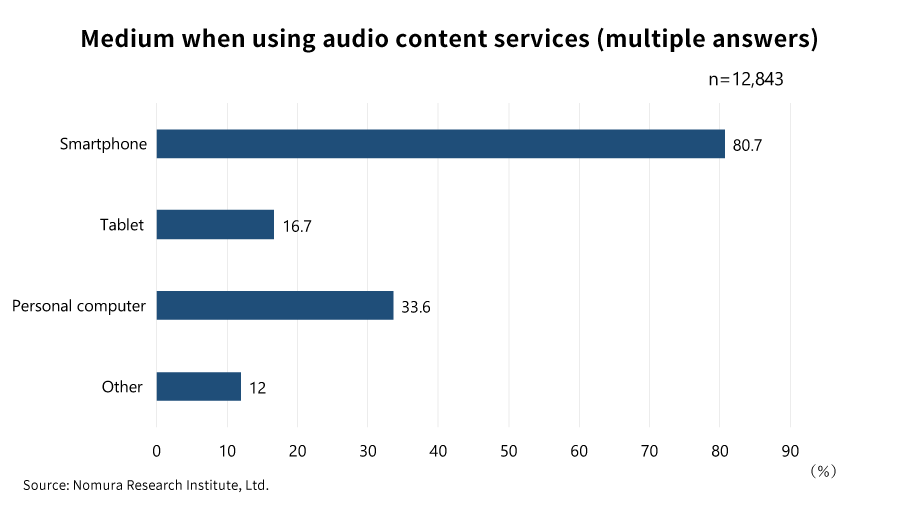
Utilizing “Disposable Listening Time”
Audio Media Marketing
Until now, audio media platforms such as podcasts and Voicy have been growing in numbers, but with the rapid rise in the user base of the voice social networking site “Clubhouse”, where users can casually talk with strangers, audio media is gathering increasing attention. We asked Junichi Mikami of NRI Netcom, who has long focused on audio while working on the utilization of audio media by companies, about market trends and future possibilities.
Audio media users are increasing
---When you say “audio media”, I think many people would think of radio.
Radio is one of the four major media (newspapers, magazines, radio, and television), but amid the rapid growth of the Internet as a new advertising medium, radio has come to be seen as a medium in decline among marketing people, including myself. However, according to interviews with radio stations and production companies, the number of radio listeners has been steadily increasing in recent years, and companies are starting to re-evaluate the value of radio.
---Why do you think use is on the rise?
The proliferation of smartphones has had a major impact. Use is on the rise because a wide array of diverse audio content is now easily available, such as radiko and podcasts that allow you to view and listen to the radio from smartphones and tablet apps, Spotify for music streaming, and audiobooks for books. When NRI Netcom polled 50,000 men and women in their 30s to 60s, excluding students, and asked them “Do you use audio media?”, more than 40% answered that they had used it before, and among current users, roughly half answered that they listened to audio media at least three days a week.

Disposable listening time is still left
---Do people often use audio media to fill gap times such as when commuting or in transit?
I think that kind of use is common with smartphones. However, it’s not just people “listening while” commuting or exercising; some people devotedly listen to music and news at home using tablets, smart speakers, and other devices.
These days, the world is overflowing with visually appealing information like text and images, and it is said that there is almost no disposable viewing time left for busy people. However, even such people still have “disposable listening time”, and have a need to use their ears to obtain information.
---How can companies use audio media?
There are three main ways to use it. The easiest to explain is placing advertisements on external audio media. The second is to publish in-house content as audio and use it for things like branding. The number of companies that publish their own content is increasing. For example, although it ended last year, Toyota Motor Corporation created a site dedicated to the luxury car line Lexus and updated it regularly with audio content that conveyed the Lexus worldview. NRI Voice, which has recently begun publishing, also falls under this type. Since professionals transmit information with their own voices, more human-like communication that is a bit different from text articles is possible. It is easy for listeners to become emotionally invested this way, and it is well suited to creating fans.
The third is marketing utilization unique to the digital era, such as having in-house audio media and leveraging things like in-house data and usage data to effectively deliver optimal information to customers. There are no examples of best practices anywhere globally yet, but it is expected that deeper communication will be possible through analysis of users and usage status, not just audio publishing.
New possibilities from data analysis and optimization
---Meanwhile, there seem to be some difficulties peculiar to audio media.
Real-time or recorded audio distribution itself is not difficult given the availability of existing audio platforms and services. Instead, what we attempted by trial and error with NRI Voice was the creation of audio content. After trying the one-person speaking format and multiple conversation formats, we decided to enlist the help of a radio production company and other professionals. Further, when communicating by voice, if your content is packed with too many elements it will not be memorable. Based on that assumption, we created the content and adjusted the length of time. Experts from various fields provide easily accessible explanations, so please give it a listen.
---What do you think about the future possibilities of audio media?
With the advent of the Internet and the fact that companies have websites, they are now free to disseminate information on their own websites, where they previously relied on print media such as newspapers and magazines. Now, by getting your own audio media, in the same way, you can create your own communication and relationships without relying on existing audio media. We are also taking on the challenge of creating a new system that includes data analysis and optimization, leveraging our strengths in system development. I hope that companies will realize the possibilities of ears as touch points.
Profile
-
Junichi Mikami
* Organization names and job titles may differ from the current version.